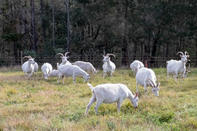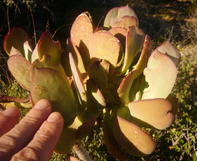Bloat in Goats
If goats have not previously been on pasture, introduce them gradually by allowing them only 30 minutes of grazing on the first day. Increase grazing time by 30 minutes each day.

This can prevent bloat caused by sudden changes in a goat’s diet. Bloat occurs when gas is trapped in the rumen and is recognised by a hugely swollen left flank. It is a life-threatening condition. Dry bloat is usually caused by eating too much grain. This can be treated by stomach tubing (in emergencies), oral bloat medicines or Milk of Magnesia.
Walk the goat a bit and feed dry coarse hay. Frothy bloat is usually caused by overeating lush, damp feeds such as clover, alfalfa or legume pastures. The tiny bubbles are impossible for a goat to belch up. To treat frothy bloat, Dr Mackie Hobson of South African Mohair Growers' Association (SAMGA) suggests: Dosing with vegetable oil (20 to 100 ml) either per mouth or tubed.
Treat with Bloat Guard® to break up the froth. This will help release the gas and increases the surface tension of the rumen fluid. The off-licence dose is about 10 ml for goats. (For cattle that weigh 200 kg, the dose is 30 ml of Bloat Guard®.) Lifting the goat’s front legs may help release the gas after Bloat Guard® treatment.
Toxic Plants for Goats

Check pastures for toxic plants like the common yew (Taxus baccata) or the leaves of stone fruit trees (cherry, peach, plum) which are deadly, even in small amounts.
Moraea (Iridaceae, tulip) and Drimia (Hyacinthaceae, or slangkop in Afrikaans) appear before the rains and may be the only greenery available. Other poisonous plants (not often found on cultivated pastures) include the puncture vine (duwweltjie in Afrikaans or Tribulus terrestris), oleander, poison leaf and the succulent, ‘plakkies’.
Parasites in Goats
A rotational grazing system is the best way to make optimal use of your land and to keep your goats healthy. You will also need enough pasture to allow the land to lay fallow (rest).
Allowing the land to lay fallow (for at least a month) allows the grass to grow back to its ideal height - 10 cm and higher, before its next use. This also prevents your land from becoming eroded and helps prevent your livestock from becoming reinfected with internal parasites.
It is important to be aware that goats on pastures will be more susceptible to infestation with internal parasites and that antiparasitic drugs might have undesirable effects on the milk. As goats browse, they shed parasite eggs and larvae onto the ground. The majority of these live below 10 cm.
By rotating your goats off a pasture that has been grazed to below 10 cm, you help minimize their exposure to parasites. Goats also become infected with internal parasites when they graze in an overly soiled pasture. The parasites are found in the goats' faeces and goats become ill after consuming them. Parasites’ life cycles continue when their eggs are passed out in the goat faeces.
Internal parasites fall into three main groups: Roundworms - wireworm is the most common and most harmful of the roundworms Tapeworms Flukes - a parasitic flatworm Roundworms (nematodes) are by far the most common internal parasite of the goat, the majority of which live in the stomach and gut, but also in the respiratory tract.
Symptoms include signs of diarrhoea and weight loss. Tapeworms can be seen as flat segments in the manure of the goats but do not cause a lot of harm to goats. The liver fluke causes liver damage and symptoms include diarrhoea, ‘bottle jaw' (swelling under the neck) and anaemia. Keep goats away from wet muddy areas.
Symptoms of internal parasite infection include paleness around the eyes, weight loss and loss of energy and appetite. The goat may have diarrhoea, coughing, a rough coat and reduced milk production. Treating internal parasites requires strategic and practical deworming. A farmer must diagnose the specific problems and ask his veterinarian for advice.
Take some samples of goat manure from one or two adults and one or two kids. The veterinarian will do an egg count to diagnose the specific infection. Please note: Information is for educational and informational purposes only and may not be construed as medical advice. The information is not intended to replace medical advice or treatment offered by your veterinarian.
By Marinda Louw